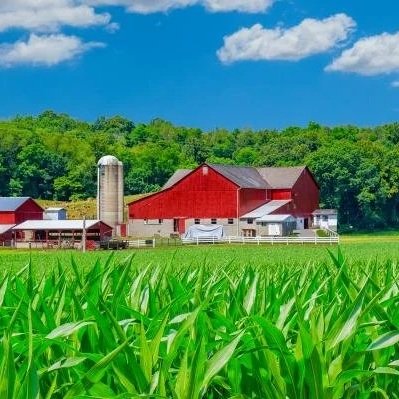Farmers National Company president Paul Schadegg sees the recently announced $12 billion in bridge payments to farmers having a variety of effects on the ag economy.
The Federal Reserve cut interest rates another quarter point last week.
Ag economist Dr. Megan Roberts with Compeer Financial says the Fed is likely responding to labor market concerns.
On Tuesday, Kennedy Rice Mill CEO Meryl Kennedy was invited on CNN to talk about the impact of President Trump's tariffs and how they are affecting the U.S. rice industry.
Today, Congressman Troy A. Carter, Sr. (D-LA), alongside Representatives Sharice Davids (D-KS), Mike Flood (R-NE), and Tracey Mann (R-KS), introduced the Securing America’s Fuels (SAF) Act, bipartisan legislation designed to strengthen the sustainable aviation fuel (SAF) industry, increase demand for American agricultural products, and reduce emissions in the transportation sector.
United States Trade Representative (USTR) Jamieson Greer told lawmakers in Washington DC that the US has received the “best ever” offer from India. This comes as US negotiators initiated their two-day trade talks in New Delhi on December 10. He added that India has been a "difficult nut to crack," citing New Delhi's opposition to importing American agricultural goods.
When Donald Trump promised new tariffs while running for president, Gene Stehly worried that trade disputes would jeopardize his international sales of corn, soybeans and wheat.
Rains from the final days of November through December 9 were sufficient to produce welcomed 1-category improvements (drought category reductions) across all of southern Louisiana.
Howdy farm folks! It looks like we have a temperature roller coaster on the way, with a little rain, but not enough to have much of an impact. Fortunately, the rains we saw last week were enough to remove the severe drought over south Louisiana, leaving only a small area centered on Natchitoches that still is classified as a D2, severe drought. We still need rain per the drought monitor, but at least it isn’t 100 degrees every day, evaporating everything in sight.
Agri-Pulse's Lydia Johnson reported that "the Agriculture Department will complete a reorganization of more than half the current D.C.-based staff to five regional hubs across the U.S. by the end of 2026, Deputy Agriculture Secretary Stephen Vaden says on Agri-Pulse Newsmakers."
US Trade Representative Jamieson Greer says the US could withdraw from its tri-lateral trade deal with Canada and Mexico. He says there are several options heading into the review of the US-Canada-Mexico Agreement in 2026. “Could it be exited?” he says. “Yes, it could be exited. Could it be revised? Yes. Could it be renegotiated? Yes. That is the purpose of that clause, and all of those things are on the table.”
Every year at the Annual Rice Awards Luncheon, the U.S. rice industry bestows three awards: Rice Farmer of the Year, the Rice Industry Award, and the Rice Lifetime Achievement Award. These annual recognitions, jointly sponsored by Horizon Ag and USA Rice, highlight some of the most positive achievements associated with the U.S. rice industry.
President Donald Trump has delivered on his promise to provide aid to U.S. farmers hit by his sweeping tariff policy, but that hasn’t freed the agriculture industry from worries of tight margins and volatile markets.
A seafood boil is rarely a bad idea, but a jungle seafood boil with an invasive species as the highlight? Now that's a creative, hands-on example of how locals can tackle a growing ecological challenge.
The U.S. Department of Agriculture’s (USDA) National Agricultural Statistics Service (NASS) will conduct the 2025 Organic Survey. In Early December, NASS will mail survey codes to respondents with an invitation to reply online. NASS will follow up by mailing the full questionnaire in early January. Last conducted in 2021, this Census of Agriculture special study will look to gather new data on organic production, marketing practice, income, and expenses in the United States. This effort is critical to help determine the economic impact of organic agriculture production on the nation. The results will be available on October 30, 2026.
Bloomberg’s Skylar Woodhouse reported that “President Donald Trump pressured farm-equipment manufacturers to drop prices for tractors as he announced $12 billion in farmer relief, his latest efforts to address Americans’ concerns about shaky economic conditions under his leadership.”
Farmer-leaders of the United Soybean Board (USB) elected Brent Gatton from Bremen, Ky., as the new chair during the organization’s December board meeting in St. Charles, Mo. He’s joined by nine newly elected farmer-leaders to serve alongside him on the Executive Committee for the upcoming year.
US growers say the Trump administration’s US$12 billion (S$15.5 billion) aid package brings temporary relief, but is unlikely to kickstart a lasting recovery for the American farm economy.
President Donald Trump on Dec 8 unveiled a package to a key base of support that includes as much as US$11 billion in one-time payments to crop farmers who have been hit hard by his tariff regime and low crop prices.
In 1803, the United States completed one of the most important land acquisitions in history: the Louisiana Purchase. For just $15 million, approximately $18 per square mile, the U.S. acquired a vast territory from France. This purchase would not only expand the nation geographically but also profoundly impact the future of American agriculture.
The 2025 USA Rice Outlook Conference General Session started local and expanded into the distant future. It began with greetings from the 88th International Rice Festival Queen Ansley Dawson and Louisiana Farm Bureau Federation President Richard Fontentot who both spoke about the importance of the rice industry, thanked attendees for joining them, and, of course, invited everyone back to the 89th International Rice Festival in Crowley, Louisiana, next October.
Rylee Symons, Pearl River, La., has earned the National Junior Angus Association’s (NJAA) Bronze award, according to Caitlyn Brandt, events and junior activities director of the American Angus Association® in Saint Joseph, Mo.
The LSU AgCenter will hold its third annual Louisiana Agricultural Outlook Forum Jan. 22.
The free event will be held at the State Evacuation Shelter, 8125 U.S. Highway 71, south of Alexandria. Doors will open for registration at 8:30 a.m. The program will begin shortly thereafter and run until 2 p.m. with a break for a provided lunch.
Unveiling a US $ 12-billion farm aid package at the White House a day ago on December 8, US president Donald Trump further raised the tariff heat on India on the topic of rice exports.
Trump’s aid package is aimed at helping farmers who are impacted by low crop prices.
Congresswoman Julia Letlow released the following statement on President Trump’s announcement of $12 billion in support for farmers affected by recent economic and trade disruptions. Letlow introduced legislation in June that would equip the Trump Administration to support farmers suffering from trade-related losses.
State and local officials, alongside Cajun Broadband, today announced the completion of a broadband deployment project in Vermilion Parish, connecting businesses in some of the parish’s largest sectors, including agriculture, healthcare and manufacturing, and delivering access to households in places like Gueydan and Erath.
Listen to the latest markets and headlines in Louisiana Agriculture on The Voice of Louisiana Agriculture Radio Network.


















































